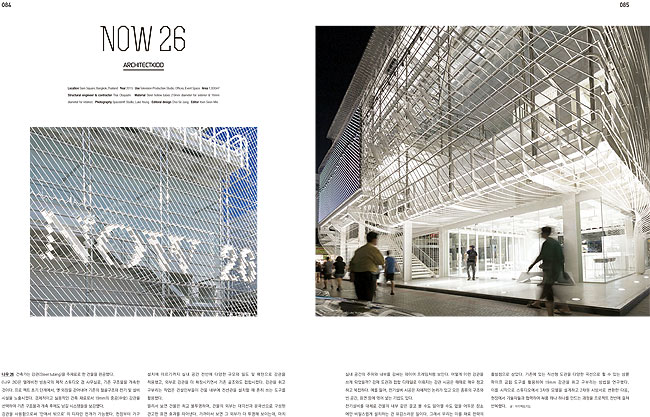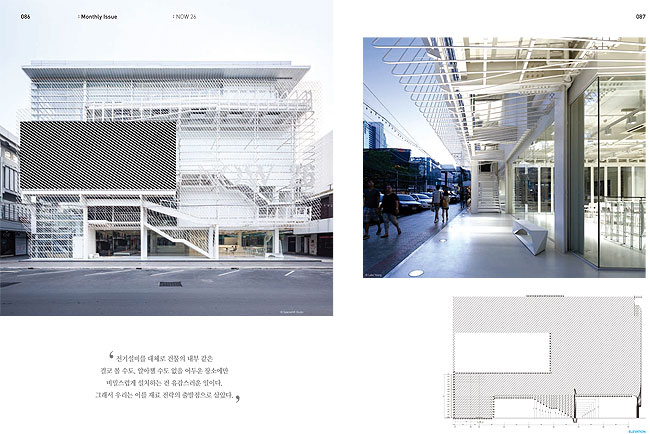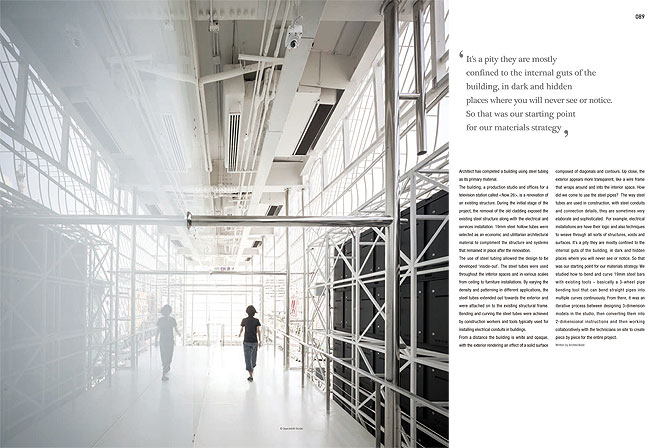NOW 26
Architect : Architectkidd



나우 26 건축가는 강관(Steel tubing)을 주재료로 한 건물을 완공했다. <나우 26>은 텔레비전 방송국의 제작 스튜디오 겸 사무실로, 기존 구조물을 개축한 것이다. 프로 젝트 초기 단계에서, 옛 외장을 걷어내어 기존의 철골구조와 전기 및 설비 시설을 노출시켰다. 경제적이고 실용적인 건축 재료로서 19mm의 중공(中空) 강관을 선택하여 기존 구조물과 개축 후에도 남길 시스템들을 보강했다. 강관을 사용함으로써 ‘안에서 밖으로’의 디자인 전개가 가능했다. 천장부터 가구 설치에 이르기까지 실내 공간 전반에 다양한 규모와 밀도 및 패턴으로 강관을 적용했고, 외부로 강관을 더 확장시키면서 기존 골조와도 접합시켰다. 강관을 휘고 구부리는 작업은 건설인부들이 건물 내부에 전선관을 설치할 때 흔히 쓰는 도구를 활용했다. 멀리서 보면 건물은 희고 불투명하며, 건물의 외부는 대각선과 윤곽선으로 구성된 견고한 표면 효과를 자아낸다. 가까이서 보면 그 외부가 더 투명해 보이는데, 마치 실내 공간의 주위와 내부를 감싸는 와이어 프레임처럼 보인다. 어떻게 이런 강관을 쓰게 되었을까? 강재 도관과 접합 디테일로 이뤄지는 강관 시공은 때때로 매우 정교 하고 복잡하다. 예를 들어, 전기설비 시공은 자체적인 논리가 있고 모든 종류의 구조와 빈 공간, 표면 등에 엮어 넣는 기법도 있다. 전기설비를 대체로 건물의 내부 같은 결코 볼 수도 알아챌 수도 없을 어두운 장소 에만 비밀스럽게 설치하는 건 유감스러운 일이다. 그래서 우리는 이를 재료 전략의 출발점으로 삼았다. 기존에 있는 직선형 도관을 다양한 곡선으로 휠 수 있는 삼륜 파이프 굽힘 도구를 활용하여 19mm 강관을 휘고 구부리는 방법을 연구했다. 이를 시작으로 스튜디오에서 3차원 모델을 설계하고 2차원 시방서로 변환한 다음, 현장에서 기술자들과 협력하여 부품 하나 하나를 만드는 과정을 프로젝트 전반에 걸쳐 반복했다.
글: 아키텍트키드
Architect has completed a building using steel tubing as its primary material. The building, a production studio and offices for a television station called [Now 26], is a renovation of an existing structure. During the initial stage of the project, the removal of the old cladding exposed the existing steel structure along with the electrical and services installation. 19mm steel hollow tubes were selected as an economic and utilitarian architectural material to compliment the structure and systems that remained in place after the renovation. The use of steel tubing allowed the design to be developed ‘inside-out’. The steel tubes were used throughout the interior spaces and in various scales from ceiling to furniture installations. By varying the density and patterning in different applications, the steel tubes extended out towards the exterior and were attached on to the existing structural frame. Bending and curving the steel tubes were achieved by construction workers and tools typically used for installing electrical conduits in buildings. From a distance the building is white and opaque, with the exterior rendering an effect of a solid surface composed of diagonals and contours. Up close, the exterior appears more transparent, like a wire frame that wraps around and into the interior space. How did we come to use the steel pipes? The way steel tubes are used in construction, with steel conduits and connection details, they are sometimes very elaborate and sophisticated. For example, electrical installations are have their logic and also techniques to weave through all sorts of structures, voids and surfaces. It’s a pity they are mostly confined to the internal guts of the building, in dark and hidden places where you will never see or notice. So that was our starting point for our materials strategy. We studied how to bend and curve 19mm steel bars with existing tools ? basically a 3-wheel pipe bending tool that can bend straight pipes into multiple curves continuously. From there, it was an iterative process between designing 3-dimension models in the studio, then converting them into 2-dimensional instructions and then working collaboratively with the technicians on site to create piece by piece for the entire project.
Written by Architectkidd
건축문화 2016년 4월호 [Monthly Issue]페이지 © 에이엔씨출판(주)